










From the rich maritime heritage of whaling towns to quaint island villages and grand seaside mansions of the Gilded Age, our small, comfortable ships can take you to the heart of New England’s most treasured destinations. Be welcomed back to your home away from home, where you can delight in the warm camaraderie of fellow guests and crew.








































January 2024 • Volume 72, No. 1
CEO Michael Shepard
SENIOR VP OF CONTENT Leon Espinoza
EDITORIAL DIRECTOR Mike Teegarden, CCC
DEPUTY EDITORIAL DIRECTOR Noble
Sprayberry
SENIOR EDITOR Jennifer Paton, CCC
ASSISTANT EDITORS Chasity Anderson, CCC; Victoria Hampton, CCC, David Herder CCC
ASSOCIATE EDITORS
Valeri Pearon, Nina Todea
PUBLICATIONS PRODUCTION MANAGER
Elizabeth Beatty
PUBLICATIONS COORDINATOR
Alyssa McDougle
Ruralite (USPS 397-460) is published monthly for members for $4.83 per year, plus postage, by Pioneer Utility Resources Inc., 5625 NE Elam Young Pkwy. Ste. 100, Hillsboro, OR 97124—a not-for-profit Oregon cooperative corporation—to serve the communication needs of 47 consumer-owned electric utilities in Oregon, Washington, Alaska, Idaho, Nevada and California. Preferred periodical postage paid at Hillsboro, Oregon, 97123 and additional mailing offices. © 2024 Pioneer Utility Resources. All rights reserved. Reproduction in whole or in part without written permission is prohibited.
Postmaster: Send address changes to Ruralite, 5625 NE Elam Young Pkwy. Ste. 100, Hillsboro, OR 97124-6454
HOW TO CONTACT RURALITE
Subscription services:
Nonmember subscriptions $15 (U.S.) per year; $25 per year (foreign). Prepayment required. Allow 4-8 weeks for first issue. Be sure to identify which local edition you want to receive.
Address Changes:
Utility members, contact your local utility. Subscribers, call us at 503-357-2105 option 3 or email mailingdept@pioneer.coop.
Back issues:
Back issues and extra copies $3. Prepayment required. Supply is limited. Be sure to identify edition, month and year. Call first if ordering back issues to check availability.
To contact Ruralite: Ruralite magazine is published by Pioneer Utility Resources.
P.O. Box 1306, North Plains, OR 97133-1306; 503-357-2105; email: info@pioneer.coop. For more information, visit www.pioneer.coop.
DISPLAY ADVERTISING INQUIRIES
American MainStreet Publications
611 S. Congress Ave., Ste. 504 Austin, TX 78704
800-626-1181 or 512-441-5200

For supplemental and interactive content, search @Ruralite on your favorite social media sites.
Welcome to the new year. I hope you enjoyed quality family time during the holidays while also staying safe and warm. Throughout the year, I hear from many of you via emails and phone calls. Most are positive comments or questions about our content. One reader last month shared that he found our magazine “weirdly engaging,” saying he just can’t put down the magazine. We’re considering adopting the phrase as our new motto!

A few readers felt our November coverage of the Honor Flight program slighted our Korean War veterans, even suggesting there was a bias against those brave soldiers. It saddens me when readers feel as if we don’t care about them. We value each and every member of our military branches, regardless of when or where they served.
We kick off 2024 with a story about a group that wants to return sea otters to the Oregon

In 6 In the Kitchen 16
Coast. These critters are a critical piece of the ecological puzzle, providing predator balance to the eccosystem.
Because no sea otters exist on the Oregon Coast, we chose to illustrate the story with an AI-generated image. This marks the first time we have used this type of illustration as the lead art for a story. Please note that we clearly labeled the image as an AI illustration. On those rare occasions we find this type of illustration to be the best option, we will be transparent about its use.
Our Up Close feature highlights STEM programs in rural communities and how they connect with industries such as farming and manufacturing. Some high school students are gaining valuable work experience as interns, taking what they learn in school and putting it into practice in the workplace.
As always, thank you for taking the time to read our work. Happy New Year!
Sincerely,
Mike Teegarden Editorial Director
STEM education forges new paths for students in rural communities Up Close, Page 10
Elakha Alliance is on a quest to restore sea otters to the Oregon Coast Spotlight, Page 12
4-5, 8, 25, 28-29, 32
When a major outage occurs, our crews restore service to the greatest number of people in the shortest time possible – until everyone has power.
1. High-Voltage Transmission Lines
These lines carry large amounts of electricity. They rarely fail but must be repaired first.
2. Distribution Substations
Crews inspect substations, which can serve hundreds or thousands of people.
can often be resolved within a few hours, but when disruptions are widespread, it may require several days of dedicated effort to restore power to all members affected.
To better grasp the restoration process, consider the analogy of a tree. Just as a tree starts at its roots and extends through its trunk to its branches, our power restoration process begins at the heart of CCEC’s electric system and radiates outward to the affected areas.
In this analogy, the repair of transmission lines mirrors the role of the tree’s trunk. These transmission lines form the foundation of our power supply and serve as the initial focus for restoration efforts. Once these critical repairs are completed, the restoration process progresses to the larger branches, which represent the distribution supply lines. These distribution lines carry electricity away from the transmission lines to specific groups of members, much like branches distribute nutrients to different parts of a tree. Restoring power at this level can energize entire neighborhoods or sections of CCEC’s service area.
Lastly, restoration efforts extend to the tree’s smaller branches. CCEC’s restoration team works methodically, moving from larger to smaller branches, making sure that power is restored to all members affected by the outage. It is important to note that restoration to the smallest branches cannot occur until repairs have been made up to this point.
During the winter months, we encourage members to take proactive steps preparing for storms. This includes:
• Emergency kits. We recommend members create emergency kits that include essential supplies such as flashlights, batteries, blankets, nonperishable food, and water. These kits can be invaluable during power outages.
3. Main Distribution Lines
Main lines serve essential facilities such as hospitals and larger communities.
4. Individual Homes and Businesses
After main line repairs are complete, we repair lines that serve individual homes and businesses.
• Backup power sources. For members who rely on electric heat, we suggest having backup heating options in place—such as a generator or alternative heating sources—to stay warm during prolonged outages.
• Clearing vegetation. Inspect and report to CCEC areas where hazardous trees and branches may be near power lines to reduce the risk of downed lines during storms.
• Communication. In case of an outage, call 866-352-9044. Stay connected with CCEC through our official communication channels for updates during outages. Reporting outages promptly helps us pinpoint affected areas more accurately.
• Community support. Support your neighbors, especially the elderly and vulnerable, during power outages. Check on them and offer assistance if needed.
Keith Buchhalter, the Marketing and Member Services Manager of CCEC, wants members to know that they can count on the cooperative for safe and reliable service, no matter what the winter season brings.
“As we approach another winter, we want to assure you that CCEC is fully committed to delivering safe and reliable service to power your lives,” Keith says. “We’ve been diligently preparing for winter by upgrading equipment, stocking up on supplies, clearing right of ways, and training our crews. While winter storms may pose challenges, our dedication to serving our members remains unshakeable. If the power goes out, we will work tirelessly until all services are restored, no matter what Mother Nature throws our way.”
Remember, reporting outages promptly and staying connected with us through our communication channels can make a significant difference in our response time during challenging times. Together, we can safely weather any storm that comes our way knowing CCEC and our community are prepared and resilient. n
Energy Star windows typically have high U-factors, a measurement of how well they insulate. Get multiple quotes for any home improvement project, including windows, and be on the lookout for rebates from utilities, state programs and the federal government.
If you aren’t buying new windows right away, consider steppingstones such as adding weatherstripping, caulking gaps and using thermal drapes.
Just like you don’t want your heated and cooled air to leak outdoors, you don’t want your air leaking into parts of the house where you never go.
If you have ductwork in an attic, crawlspace or other unairconditioned or heated area, the ducts could have leaks that increase your energy bill. According to the Department of Energy, 20% to 30% of the air moved through ducts is lost to leakage.
Hire a professional to seal your ducts, or seal them yourself with metal tape or duct mastic specifically designed for the job. Do not use duct tape, which will dry out and lose adhesion.
So far, we’ve covered three ways to keep your heated and cooled air where you want it. It turns out, how you heat or cool the air is also important.
If you’re willing to replace your furnace, or the unit is 10-plus years old, a heat pump is an efficient home heating and cooling upgrade. It can reduce heating costs by as much as 50% compared to electric resistance heating, according to the Department of Energy.
A heat pump works similarly to an air conditioner in reverse. It uses a refrigerant to pull heat energy out of the air outdoors, then moves it indoors and blows the heat into your living areas.
Also consider a heat pump water heater, which has all the same advantages but heats water rather than air.
If a heater turns on, but nobody is there to hear it, does it make a noise? One thing we know is that it would impact your energy bill.

Before starting a project, it is important to take a step back and consider, “What will make the biggest impact?” This means knowing how efficient your house is and where the energy use is going.
A home energy assessment looks for air leaks, insufficient insulation, energy-hog appliances or other issues, and evaluates your total energy use. Conducting a home energy assessment lets you know where any inefficiencies in your house are, giving you a blueprint for fixing them.
Many utilities offer assessment programs, and the Department of Energy offers guides on assessments— including tips for a do-it-yourself assessment—at www.energy.gov/energysaver/home-energy-assessments.
Both programmable and smart thermostats help people save energy by changing the temperature throughout the day. You can save 10% on energy bills by turning back the thermostat 10% to 15% for eight hours a day, according to the Department of Energy.
Whether that means heating or cooling less during the day while you’re at work or turning things down while you’re sleeping, a programmable thermostat ensures you’re only heating and cooling the air you feel. n

Coos-Curry Electric Cooperative Inc. is searching for members who have unclaimed capital credit checks issued in 2019. If you were a member who received electric service from CCEC during 1990 and 1991, there may be check from 2019 with your name on it for your capital credits.
The names of members who have unclaimed capital credits paid in 2019 will appear in a special insert within the Curry Coastal Pilot newspaper. The insert will be published at least one time in January, February, March and April 2024. You can also visit www.ccec.coop/capital-credits to view the list.
What are capital credits?
Go to www.ccec.coop/capital-credits to see if your name appears on the list, or if you know the address or phone number of a person or business on the list.
If you are not the member listed, you must be legally authorized to claim one of these checks, including checks for members who are deceased.
A form is available to fill out on the CCEC website. Please provide your name, the listed member’s name and telephone number. A member of our team will contact you as soon as possible. For additional questions, contact us at 541-332-3931 or by email at capitalcredits@cooscurryelectric.com.
Unclaimed capital credits will be forfeited and reclaimed by Coos-Curry Electric as permanent equity six months after the last published notice. A portion of the reclaimed capital credits are distributed to community organizations as charitable donations for the benefit of the communities we serve. n Find out
Capital credits reflect each member’s ownership in the cooperative. Other businesses and utilities return profits to investors and shareholders. Not us. CCEC is a member-owned not-for-profit cooperative. We return margins—or profits—as capital credits to members like you. Members invest in CCEC when they buy power. Each year, after all expenses have been paid, any remaining margins are allocated to members as capital credits in proportion to their electric use.
Visit www.ccec.coop/capital-credits to view the unclaimed capital credit list.

By Chiara Profenna
Soaring above a golden expanse of wheat, drones whiz through the air, not just counting crops but playing a pivotal role in detecting disease and sowing the seeds of tomorrow’s harvest.
In the heart of rural America, a technological revolution continues. A new future of machinery, automation and cutting-edge technology is touching down in our communities.
As our world undergoes this transformation, there is a pressing need for a workforce equipped to navigate this new frontier. Enter STEM education, where science, technology, engineering and math are the soil in which the next generation matures to take over this ever-changing landscape.
As the needs of the workforce evolve, education practices are shifting to meet the latest demands. The most recent is a surge in STEM careers in rural areas. According to the U.S. Bureau of Labor Statistics, STEM
occupations grew 79% in the past 30 years. Rural communities feel this change more than most, according to STEM professionals across the Pacific Northwest.
“All jobs in the workforce right now basically require some level of STEM literacy,” says Holly Bringman, coordinator for the Apple STEM Network in North Central Washington. “And that’s one of the critical shifts. How we live and work in general is more technical.”
The Apple STEM Network is just one of the many organizations creating partnerships across the education system— improving pathways for students seeking STEM careers in rural communities.
From Classrooms to Warehouses STEM education in rural communities reflects this change in workforce demand, with more schools and resources focused on finding ways to bring STEM to students.
One such development is careerconnected learning, a framework
emphasizing career awareness, exploration and training that directly reflects professional and industry expectations. By collaborating with industry partners, educational STEM hubs and schools can offer students unique internships and work-study programs.
In a collaboration among the Central Oregon STEM Hub, High Desert Education Service District and KEITH Manufacturing Co. in Madras, Oregon, high school students interned on the floor of the KEITH warehouse during the summer.
“This summer was the first year that we’re actually able to give the students hands-on experience,” says Mike Feigner, KEITH’s plant manager. “They came in here every day and built our product. And they walked away knowing that they can do these skills and that they can work in a place like this.”
The program was deemed a success in its inaugural year, with one student intern receiving a job offer at the end of

Students and educators explore STEM learning resources to support more diverse forms of teaching outside of the classroom. PHOTOS
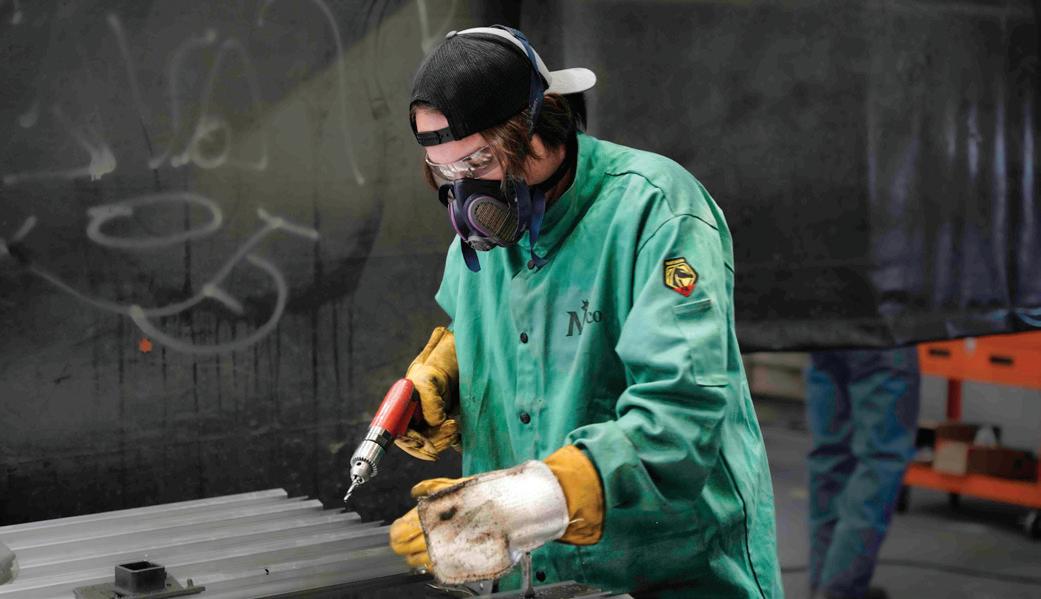
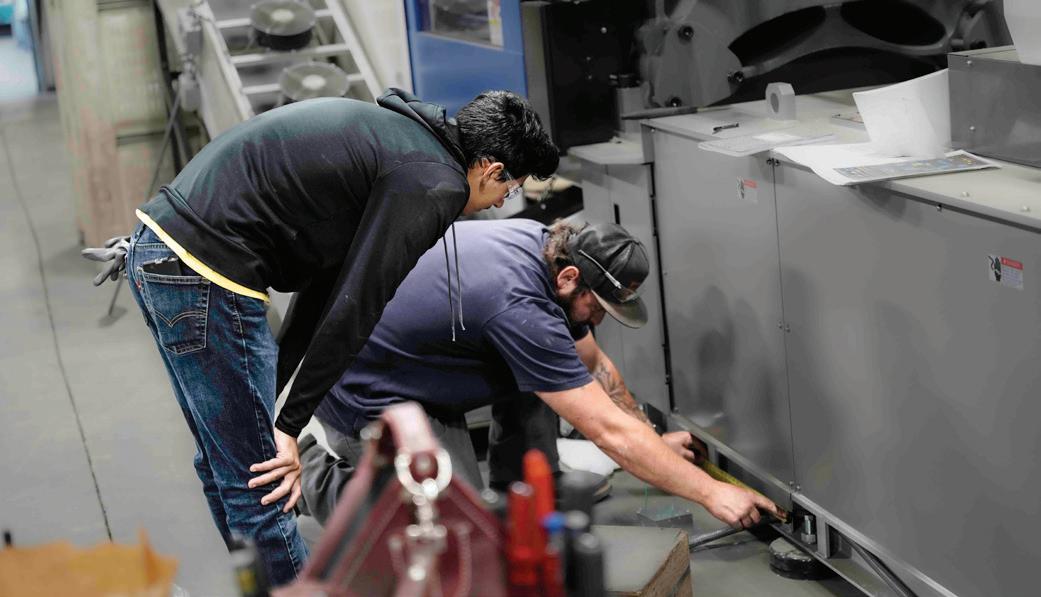
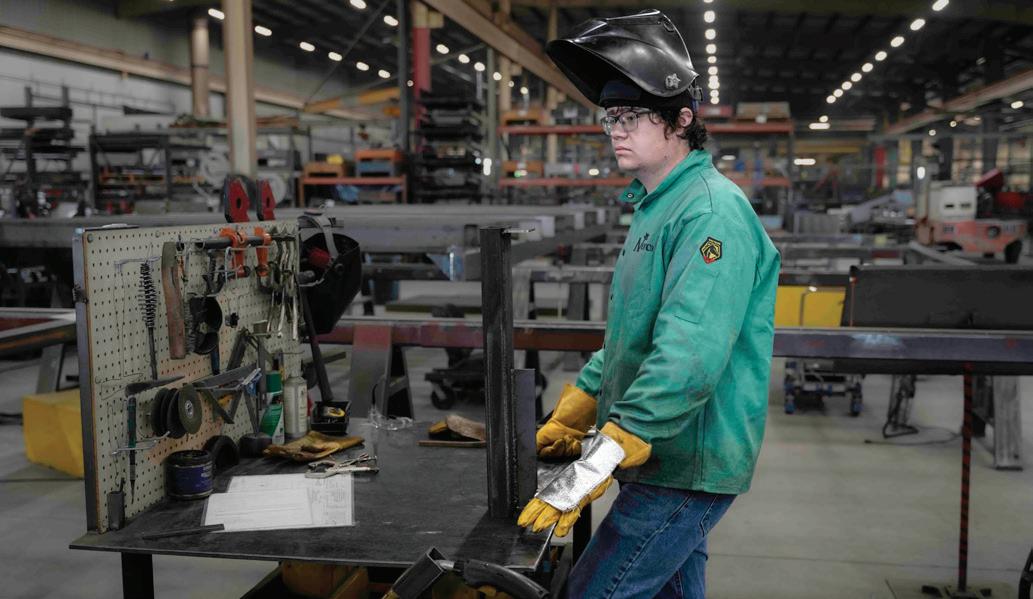

the summer. Chris Hug, a Madras High School graduate, is a machine operator at KEITH.
From his experience in high school manufacturing classes, Chris had a strong foundation to build upon during his internship.
“They taught us a whole lot about how to operate machines, better welding techniques, good electrical advice,” Chris says. “I knew I could definitely tackle a manufacturing career.”
Through career-connected programs, rural STEM hubs can build and inspire their workforces by allowing high school students to see a future for themselves in STEM careers.
“People are recognizing that there are many careers out there that are STEM that we didn’t see as STEM before,” says Erica
Compton, executive director of the Idaho STEM Ecosystem.
In rural Idaho, community-connected learning is flourishing in the education system.
“A trend that I’m seeing in students, especially in rural communities, is that beyond career-connected learning, what they’re really hungry for is communityconnected learning,” says Crispin Gravatt, communications manager at Idaho STEM Action Center. “They really are wanting to make sure that their communities are as evergreen as they can be. Parents want their students to feel like they can have a life in the communities that they love.”
In rural areas, community-centered approaches can show students they don’t
need to leave home to find better career opportunities.
As STEM education in rural communities propels students toward new horizons, the landscape of possibilities continues to expand. With strong support systems in place, students can transform their communities in more ways than they can dream of.
“What we’re focusing on at Oregon STEM and the STEM hubs is the awareness gap,” says Deb Mumm-Hill, Oregon STEM executive director. “First of all, you can’t envision and be what you can’t see. And the technology and the STEM industry—a lot of it is invisible. So, unless your parents, your school or your ZIP code can show you these invisible, amazing careers, you can’t dream to be them if you can’t see them.” n
The Oregon Coast, with its rugged cliffs and abundant marine life, holds a special place in the hearts of locals and visitors. Yet, it's been missing a critical piece of its ecological puzzle for decades: the sea otter. Elakha Alliance, a dedicated advocacy group, wants to complete that puzzle.
Since 2018, the nonprofit has aspired to restore the sea otter population to the Oregon Coast through advocacy, scientific research and educational awareness.
The alliance’s history goes back about 20 years, when David Hatch questioned the return of sea otters. At the time, David was the Oregon Coast Indian Tribes’ representative on the Oregon Ocean Policy Advisory Council.
One of the council’s staff members was Bob Bailey, an employee at the Department of Land Conservation and Development. During their time on the council, David and Bob became acquainted through their mutual passion for coastal conservation. During one of their conversations, David mentioned sea otters.
“He had built a small boat,” Bob says. “And in the process of building that small boat, was looking for a name for it. He
ran across the word elakha, which in the Chinook trade jargon means sea otter. He ended up naming his little boat ‘The Elakha.’ But it also set him on a path toward understanding and coming to realize sea otters had once been part of the lives of Indigenous people all along the Oregon Coast and beyond.”
David began sharing information about sea otters and seeking ways to create change. Through tribal and non-Indigenous connections, he gathered resources to support his project.
“Dave was out spreading the gospel, as it were, about returning sea otters,” Bob says.
Many years later, in 2016, Bob recalled this encounter. He reached out to David to see what had become of the sea otters.
“I didn't hear back from him and came to find out some weeks later that he had died quite tragically and suddenly that particular week,” Bob says. “[It] was devastating, of course, to his friends and family and all of us.”
Not wanting David’s life’s work to die with him, Bob took up David's mission and formed Elakha Alliance.
The organization was incorporated in 2018. Since then, it has supported many steppingstones in the long and arduous path of species reintroduction.



Today, a notable 800-mile divide separates the sea otter populations of Northern Washington and Southern California—a gap that emerged more than a century ago. The near extinction of sea otters resulted from intensive hunting by fur traders in the 18th and 19th centuries.
While this important ecological marine mammal was lost to overhunting, the lives and culture of Indigenous people along the coast were also deeply affected.
Sea otters held a profound spiritual and cultural significance in the lives of these communities, as evidenced by archaeological findings and passed-down wisdom. Elakha Alliance, a collaboration among tribal, nonprofit and conservation leaders, strives to rekindle this cultural connection in partnership with Native coastal communities in Oregon. Its board of directors includes representation from these Native communities, including Robert Kentta, a member of the Confederated Tribes of Siletz Indians.
“Sea otters represent prosperity to us in our traditional stories,” Robert says. “That’s an important cultural connection we’re missing without sea otters being present here on the coast.”
For more than 5,000 years, sea otters
lived in harmony with humans along the Oregon Coast. Their extinction from the region holds a symbolic significance to Indigenous people.
“The history of the loss of sea otters coincided with the loss by Indigenous people of their homelands and way of life along the Oregon Coast,” Bob says.
In the 19th century, Indigenous communities were affected by numerous catastrophes. War, disease, loss of their lands and lives, and relentless persecution and stigmas plagued Native communities.
The restoration of sea otters to the coast is indicative of healing the relationships between Indigenous communities and the land, Bob says. While the tragedies of history cannot be reversed, Elakha Alliance hopes to bring balance back to the community and restore an integral piece of Native culture to the land.
“It would be cultural restoration in that ability to see our oceanscape as it once was, not all that long ago,” Robert says.
As a keystone species, sea otters would play a vital role in maintaining the health of coastal ecosystems if reintroduced. Their presence would affect coastal regions— directly and indirectly—in many ways.

A growing sea otter population would indirectly increase kelp forests, eelgrass beds and the species that rely on these habitats. Their feeding behaviors would likely lead to a decrease in a variety of prey species, such as Dungeness crab.
Elakha Alliance has taken positive and negative effects into account by conducting a variety of studies. A feasibility study, completed in 2020, found that restoring sea otters is biologically feasible.
“We had six world-renowned scientists work on the 200-plus page document,” says Jane Bacchieri, executive director of Elakha Alliance.
The study looked at the elements necessary for a sea otter population to be restored in Oregon. It included an in-depth analysis of ecology, habitat, genetics and other biological factors.
It also led to more studies on the socioeconomic impacts on fishing industries and tourism. These additional studies—the Oregon Sea Otter



Reintroduction Economic Study and the South Coast Tourism Impact Study—investigated some of the broader changes sea otters would make in coastal communities. Those changes could include a spike in tourism and a decrease in shellfish and crab that could be offset by an increase in finfish production.
“The coast belongs to everybody,” Jane says. “Our efforts are statewide; in some cases, beyond state boundaries.”
Using these studies, Elakha Alliance works with the U.S. Fish and Wildlife Service, which has the regulatory authority to bring back sea otters.
Reintroducing sea otters to the Oregon Coast is a long and complicated process. However, with advocacy and support from Elakha Alliance, it is becoming more feasible each day.
The Elakha Alliance strategic plan
comprises four main steps. Its first initiative included the feasibility study and the following impact studies. At the same time, the alliance’s second step is working to build regional consensus that restoring sea otters is a goal worth pursuing.
The third step of the initiative is reintroducing sea otters along the Oregon Coast and monitoring their progress diligently. Initial work may begin in 2025, although it’s too early to gauge when sea otters will be fully reintroduced. Ongoing monitoring is expected to last for decades.
The last step is to strengthen the organization itself. Key strategies involve public involvement— especially from affected groups— and forming partnerships with organizations sharing the alliance’s vision. The group’s work will be far from over once its key mission is achieved.
“I think there’s going to be a role for Elakha to continue to serve as an advocate for the animals,” Jane says. “At the end of the day, if we’re successful, we might not need to exist as the Elakha Alliance anymore. It might be broader ocean stewardship or something like that. I think we will be flexible and nimble to be value-added wherever we can be.” n
Learn more about Elakha Alliance at elakhaalliance.org.

Reintroducing Keystone Species in the Pacific Northwest
Keystone species play a pivotal role in maintaining ecosystem balance. The Pacific Northwest has seen many successful reintroductions as well as more challenging cases.
In the mid-1990s, gray wolves were successfully reintroduced in Yellowstone National Park. Through careful planning and research, their presence led to a cascade of positive effects and increased biodiversity in the ecosystems. Elk and deer populations rebalanced, allowing willows and aspen to flourish.
In a less successful attempt, translocating sea otters from Alaska to the Oregon Coast in the 1970s became a lesson in the importance of monitoring populations after reintroduction. Not long after the sea otters were brought to Oregon, their population slowly dwindled until the coast was once again left without them.
Careful planning, consideration of ecological dynamics and consistent monitoring are some of the most crucial factors in a successful reintroduction.









Graham Cracker Picnic Mix
¼ cup vegetable oil
¼ cup sugar
5 to 6 drops pink neon liquid food color
½ cup unpopped popcorn kernels
1 package mini pastel marshmallows
1 cup bear-shaped graham crackers
1 package white fudge-covered pretzels
1 cup mini cookies
In a large pot over medium heat, stir oil, sugar and food coloring. Stir in the popcorn kernels. Cover. Cook until popcorn begins to pop. Shake pot over heat until popping slows.
Remove pan from heat. Pour popcorn into a large bowl. Add marshmallows, graham crackers, pretzels and cookies. Toss lightly.
8 cups popped popcorn
2 tablespoons raspberry jam
3 tablespoons smooth peanut butter
½ cup white chocolate chips
¼ cup freeze-dried strawberries
¼ cup dried cranberries
In a large bowl, stir together popcorn and jam until evenly coated. Transfer to a parchment paper-lined baking sheet. In a double boiler over barely simmering water, add peanut butter and white chocolate chips. Cook, stirring occasionally, for 3 to 5 minutes, or until smooth and melted.
Drizzle peanut butter mixture over the popcorn mixture. Sprinkle with strawberries and cranberries.
Refrigerate for 10 minutes or until the peanut butter mixture is set. Break into pieces to serve. Store in an airtight container in the refrigerator for up to one week.
6 quarts popped popcorn
Olive oil cooking spray
1 cup grated Parmesan cheese
2 teaspoons garlic salt
2 teaspoons paprika
1 tablespoon Italian seasoning
Place popcorn in a large, sealable plastic container or a 2½-gallon plastic sealable bag.
Spray popcorn lightly with cooking spray. Sprinkle cheese, garlic salt, paprika and Italian seasoning over popcorn. Shake to distribute evenly.
12 cups unsalted, unbuttered, popped popcorn
4 cups mini marshmallows
2 tablespoons butter or light olive oil
½ teaspoon salt
1 tablespoon green food coloring
¼ teaspoon peppermint extract
1 cup green candy-coated chocolate candies
Place popcorn in a large mixing bowl. In a saucepan over medium heat, melt marshmallows, butter and salt. Stir occasionally until smooth. Remove from heat. Stir in food coloring and peppermint extract.
Toss marshmallow mixture with popcorn. Cool for 2 to 3 minutes or until cool enough to handle. Toss with chocolate candies.
Shape 3 tablespoons of popcorn mixture into a small cluster. Place on a wax paper-lined baking sheet. Repeat with the remaining popcorn mixture. Cool completely.
¼ cup freeze-dried strawberries, ground 6 cups popped popcorn
1 cup white chocolate chips, melted
In a small food processor or spice grinder, pulse freezedried strawberries until finely ground.
Place popcorn in a large bowl. Drizzle melted chocolate over the top. Toss until well-coated. Sprinkle evenly with ground strawberries. Toss until well-coated.
Scrape popcorn onto a large parchment paper-lined baking sheet, spreading into an even layer.
Let stand at room temperature for 30 to 60 minutes, or until chocolate is set and hardened. To serve, break into pieces.
5 cups popped popcorn
12 ounces white chocolate chips or chopped white chocolate
1 cup crushed hard candy peppermints
Cover a baking sheet with foil or wax paper. Set aside. Place popcorn in a large bowl. Set aside.
In a double boiler over barely simmering water, melt chocolate, stirring until smooth. Stir in crushed peppermints.
Pour the chocolate mixture over the popcorn mixture. Stir to coat. Spread onto prepared sheet. Cool completely.
When chocolate is cooled and set, break into chunks for serving. Store in an airtight container at room temperature.
8 cups popped popcorn
½ cup chopped toasted pecans
1⁄3 cup maple syrup
1 tablespoon bourbon
2 tablespoons butter
1 tablespoon orange zest
1 dash bitters
Place popcorn and pecans in a large bowl.
In a small saucepan over medium-high heat, combine maple syrup, bourbon and butter. Bring to a boil. Cook, swirling pan, for 3 to 5 minutes or until mixture thickens to corn syrup consistency. Stir in orange zest and bitters.
Drizzle maple syrup mixture over popcorn. Toss to evenly coat. Cool completely before serving.
Options: Substitute bourbon with rye or whiskey. For mocktail popcorn, substitute with nonalcoholic bourbon or whiskey.
I am learning the technique of Swedish huck weaving and am having a difficult time trying to find huck weave materials in Alaska. If you have any huck weave materials that you would be interested in getting rid of, I would love to have them. Thank you.
Nancy Riley P.O. Box 57030 North Pole, AK 99705
I would appreciate unwanted jewelry—old, new or broken. Also, unmatched earrings and unwanted watches. Thank you.
Carol Semenko 145 Chukar Lane Alturas, CA 96101
I am requesting large—about 2 inches—wooden thread spools. A friend carves faces into them. Thank you.
Barbara Cadwell
950 Pomona St., Unit 228 The Dalles, OR 97058 bpcadwell228@gmail.com
I have a flat rate USPS box stuffed full of wool, yarn, needles and other knitting accessories that I would like to give away. If you are interested, contact me by email, and I will be happy to mail them to you free of charge.
Pat Sunday
7096 N.E. Stonewater St. Hillsboro, OR 97124-7282 suncia@icloud.com
Milestones
My mother will be 94 years young in January. I know she would be happy to receive birthday cards. Mail to: Mary Ann Cline, 2221 Oak St., Apt. 329, Forest Grove, OR 97116. Thank you.
Carol Davis Vernonia, Oregon
My mother, Gail Simmons, turns 80 in January. She has been a nurse since I was a child, and she’s still a nurse in the same assisted living facility after more than 30 years. She is a very caring nurse for the elderly, ensuring her residents receive the best care possible while working through the pandemic. She is what you would expect in a nurse—always giving instead of receiving. If you asked her why she still works today, she would tell you it’s in her DNA and it’s what she lives for. I would love to see her face glowing with pride receiving birthday wishes and words of encouragement. Thank you for your letters and cards in advance. Send to: Gail Simmons, 1699 N. Terry St, Space 155, Eugene, OR 97402.
Robert Shafer Heppner, Oregon
Have a Happy New Year!
My dear friend turns 91 in January. She is a retired school teacher with a strong sense of humor and amazing stories to share. Her birthday would be so special if you could send cards. Thank you in advance. Send to: F. Hart c/o 46383 Brahman Way, Pendleton, OR 97801.
Sandra Pendleton, Oregon
Looking for images and stories of Oregon Army and Navy airfields directly before and during World War II that were used by the military. Will pay postage and return images. Needed for academic research.
Andi Journey P.O. Box 226 Crescent, OR 97733
If anyone is interested in metal pull tabs off cans, we have bags that can be sent to you. Contact me, and I’ll get them on the way.
Peggy Timms 19 Cedar Drive Hermiston, OR 97838
North Powder Charter School is accepting donations of new or used playing cards and dice. These will be used to create math games for students and their families. Items can be mailed or delivered before March 1 to: NPCS, 333 G St., North Powder, OR 97867.
Allie Scott North Powder, Oregon
Send your request (no attachments) to readerexchange@ ruralite.org or mail to Reader Exchange, 5625 NE Elam Young Parkway, Suite 100, Hillsboro, OR 97124. Fill in the subject line with Reader Exchange.
Acceptance, scheduling and editing are at the editor’s discretion. Single requests only, please. No duplicates.
Submissions are handled first-come, first-served as space allows. We cannot honor every request.
Please affirm you have authorization from all appropriate parties before submitting. By submitting, you indemnify Reader Exchange, Pioneer Utility Resources Inc., its officers, directors, employees, utility clients and insurers from all legal liability incurred by the publication of information.
We no longer accept pen pal requests. You may submit a pen pal request as a Marketplace ad (pricing applies).
When submitting a milestone request, please send it at least two months before the milestone.
Phone numbers are not published. Email addresses are if part of the ad, but you must include a postal address.
Requests must include the name and address of the electric utility that provides your magazine.









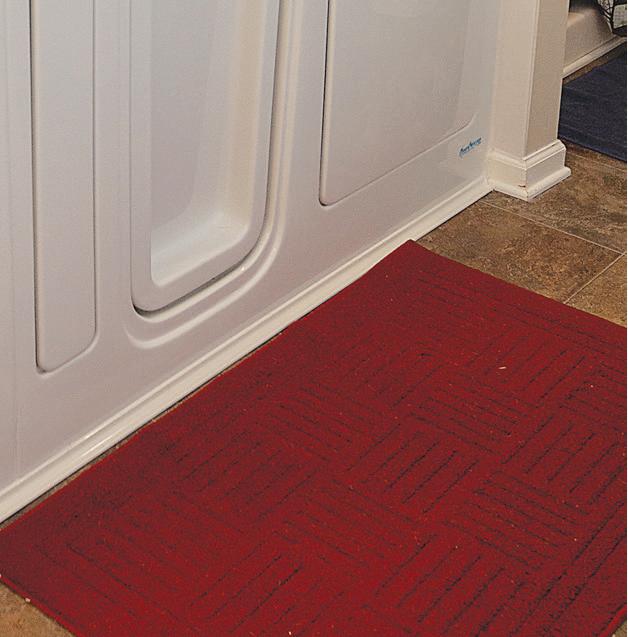








Hop into history at the Hagerman Fossil Beds in Southern Idaho, and experience one of the world’s largest fossil deposits from the Pliocene epoch—roughly 3 to 5 million years ago.
In 1928, a local rancher named Elmer Cook saw fossil deposits eroding along the Snake River. He contacted the United States Geological Survey, which in turn notified the Smithsonian Institution. The Smithsonian conducted four expeditions between 1929 and 1934.
The Smithsonian digs unearthed more than 200 fossils of Equus simplicidens, a predecessor of horses, that more closely resembled zebras. Finding so many fossils together helped researchers realize these horses were likely pack animals. The digs also found previously unfound species such as Platygonus pearcei, an early javelina.
The Thousand Springs Visitor Center opened in 2022, and is a great place to learn about a century of research at the site. The center has exhibits featuring fossils and the knowledge gained at the site, as well as ranger talks to guide visitors through the information.
Until March, the visitor center is open 9 a.m. to 3 p.m. Friday through Sunday. To plan your trip, call 208-933-4105 or visit www.nps.gov/hafo.
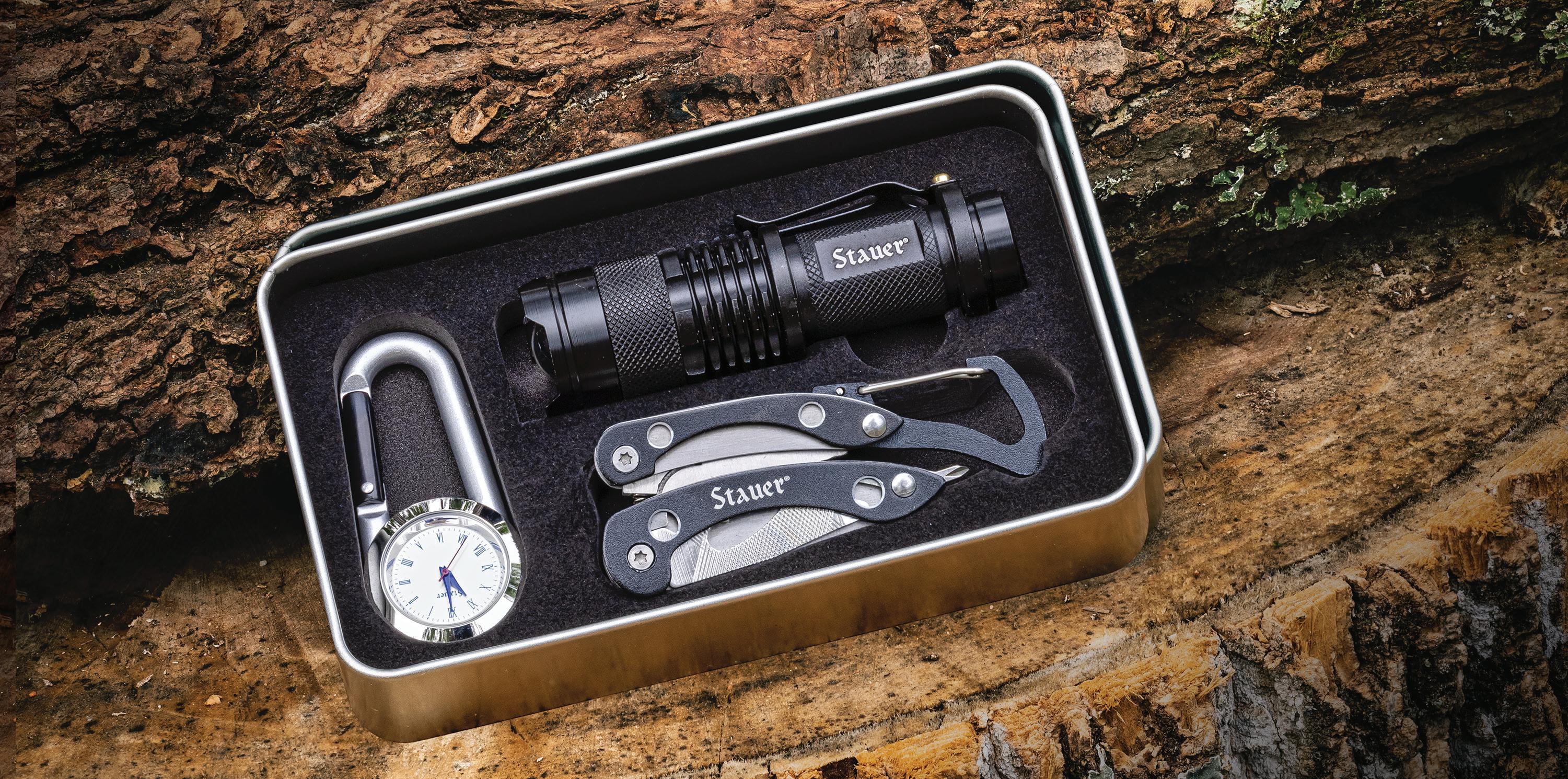
On any outdoor adventure, Mother Nature’s job is to present you with challenges. Some days she’s more demanding than others. And on those days, you’d better come prepared. The Stauer Survival Box is a near-guarantee you’ll be up to the challenge. The stainless steel multitool offers wire cutters, knife, bottle opener, file, a set of screwdrivers, a pair of pliers and much more. The powerful flashlight has three different settings, and the tactical loop watch is a reliable, waterresistant timepiece that clips to your hip and never leaves your side. All told, opening the Survival Box gives you instant access to nine different tools for JUST $19.50.
Regularly sold for $99, we’re offering this collection of survival essentials to you for A FIFTH OF THE NORMAL PRICE! Why? Because we’ve had an incredible year and we feel like giving back to our valued customers. As this kit has proven to be one of our all-time best sellers, we can only extend this offer while supplies last. Of our initial run of 1,737, more than half have already sold. Your move, Mother Nature.
Survival Box Specifications:
• Multitool: 3 1/4" x 1" folded
• Flashlight: 3 1/2" x 1", 260 lumens, takes AA batteries (not included), three LED light modes: strong, medium and caution flashing
• Watch: 2 3/4" x 1", battery type SR626SW (included)
Survival Box $99 $19.50* + S+P Save $79.50
*You must use Insider Offer Code: SVB185-01 to get this price. California residents please call regarding Proposition 65 regulations before purchasing this product. 1-800-333-2045
Your Insider Offer Code: SVB185-01
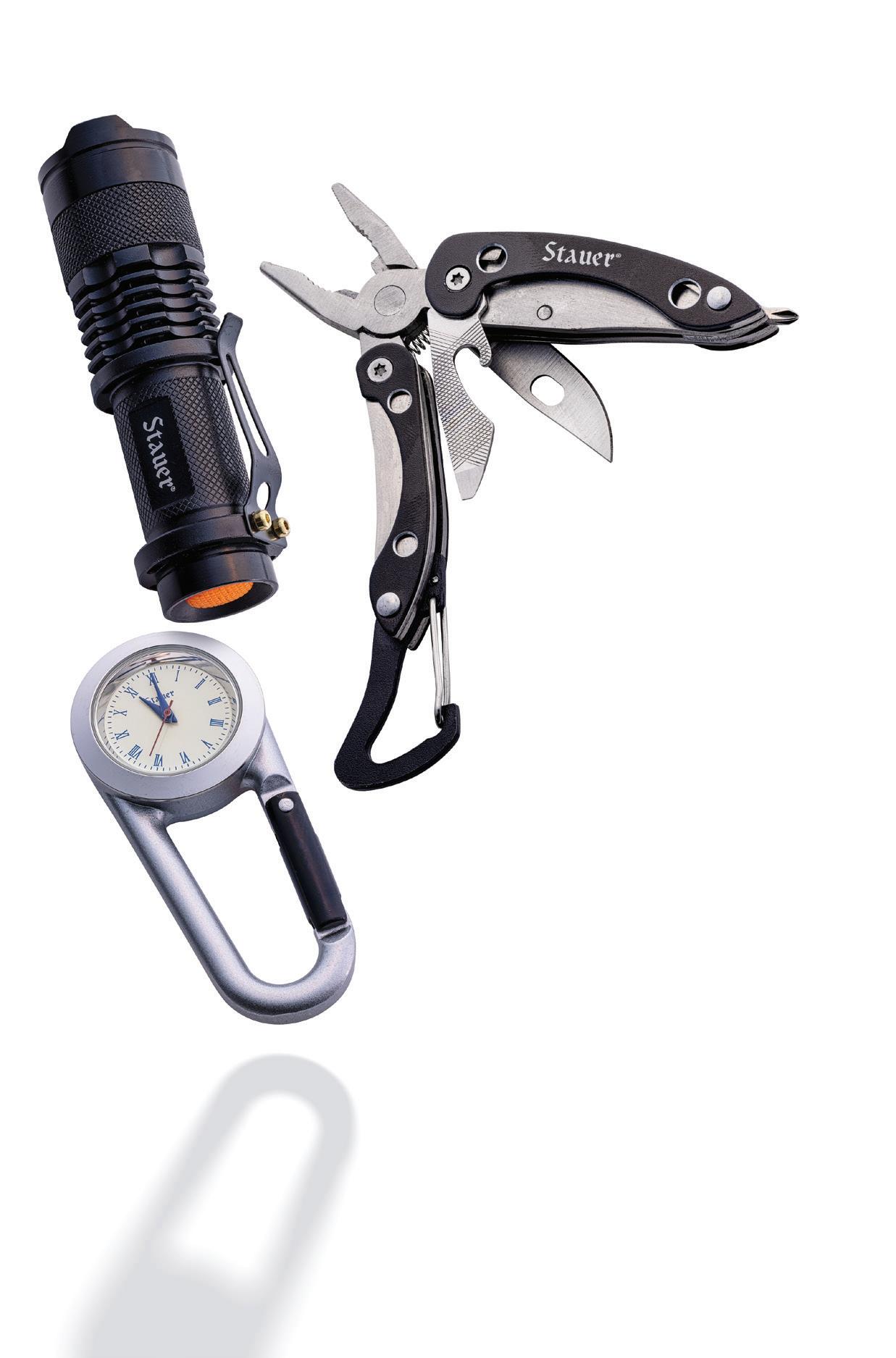
Regularly priced at $99, take advantage of this special offer while supplies last!
Praise for Stauer’s Survival Box “[It] has everything!” — Carol T., Anaheim, CA
Box includes flashlight, watch and multitool with wire cutters, knife, bottle opener, file, screwdrivers, pliers and more!

My heart is heavy.
One of the true blessings of writing a column is the opportunity to share with you, my readers, not only what I see but what is on my heart. The two are often interconnected. As trite as it sounds, I feel like we are family.
In the wake of the most recent war atrocities, it’s challenging to keep my attention on things like photography and positive storytelling. Yet, even as I wade through the

emotions of these conflicts, I am reminded what a lifelong gift photography is, distracting me from deep and painful events while acting as a vehicle to share what I see and feel. For this, I am forever grateful.
Armed with a purpose, photography has always been a powerful communication tool. With it, we can shine light in dark places or quietly applaud acts of love and goodness. I believe both are necessary. While I truly admire the courage of my friends who risk their lives to show us the injustices and atrocities of war, I have chosen to celebrate light and those who reflect it.
Where there is light, there is hope. The new year is the perfect time to talk about seeing and being light. Whether
literal or metaphoric, light reveals and heals. Each of us chooses how we use light. With our cameras, as with our words, we can choose to focus on the good and lovely in our world or dwell on the dark, ugly and evil.
I attended a seminar where the speaker reminded his audience of the difference between a thermometer and a thermostat. One reads the temperature, and the other changes it, he challenged.
The late Agnes Baker Pilgrim—also known as Grandma Aggie, a Native American spiritual elder I wrote about a few years ago— said she talked to water, thanking it often. She insisted water hears us. I think light is similar. I know it has a voice. n
Show me the goodness of light, as it falls on mountains, fields, streams, rooftops, bedsheets or kitchen sinks. Or, as it springs forth from the heart in acts of kindness.
Email your best image (just one, please) with caption information, including an explanation of how it affects you, to GPH@pur.coop. We may share submissions on our website and social media channels.





































Reinforced custom-sized pond liners (39 cents/sqft). Hay covers, greenhouse covers, any width and length. Truck tarps and more. High puncture and tear strength. Best price guaranteed. Celebrating 42 years in business. www.btlliners.com. 541-447-0712. 0424
4x5 round bales, Meadow Foxtail Orchard Grass. 4x4 Timothy, small square. 208-4354637 or 208-435-4002; nas@cpcinternet.com.
Wade Rain 40’x3” irrigation pipe. Used in solid set operation, in good condition. 541-752-0460; westernaglands@gmail.com. 0124
Antiques and Collectibles
Buying antiques and collectibles: advertising signs, porcelain signs, gas pumps, beer signs, antique toys, cast-iron coin banks, neon signs and more. Jason, 503-310-3321 or tjabaughman@yahoo.com. 0324
Melodeon circa 1867 Taylor & Farley made in Worcester, MA. Mahogany case, good condition, playable. Circular stool. Photos available. Gale, 360-468-4618 or lynch@rockisland.com. 0124
Buying American Indian collectibles, Navajo blankets and rugs, baskets, beadwork, etc. Also, quality paintings of the early Southwest and Americas. Send photos or contact: 760-409-3117 or amer.ind.baskets@gmail.com.
Lifetime collection Fender vintage amps 1960s70s. Serious inquiries only. 541-589-2807.
Automotive
Wanted: mid-1960s 2-door Ford Falcon, Fairland or Mercury Comet/Cyclone. Grandkids have outgrown my ‘66 Ranchero, need something with a back seat. Dan, 541-663-9091. 0224
Boats
1979 Skipjack. 20-ft open cruiser. $10K. High top, stern cover, full boat cover. 305 Chevy engine depth finder and plotter; CB/VHF radio, OMC out-drive. Always garaged. Runs good. Photos available. Ontheroad4me@gmx.com.
Books, Magazines, Videos
Book restoration. Bibles, cookbooks, cherished family heirlooms. Beautiful work. We give renewed life, more durable than original, to last for generations. 775-537-7066; salacanstudio@gmail.com. 0124AR
Business Opportunities
A great business opportunity in Boardman, OR. A small cafe you can use your imagination in. Frontage view of freeway, quick in and out access. A coffee shop on property for extra income. $1.3M. For more information, contact Karen at 541-571-0636. 0124
Ads 25 words or fewer are $35 a month. An extended ad of up to 35 words is $50 a month. Contact information is included in the word count. Phone numbers and emails count as one word.
Longer ads may be placed. Contact 503-357-2105 or info@pioneer.coop for pricing information.
Ads are for customers of member co-ops, public utility districts and municipals only. Subscribers and nonmembers may inquire about pricing at 503-357-2105 or info@pioneer.coop.
Ads must be direct and in first person, and are subject to approval and editing.
Closing deadlines (in our office): March issue—January 28, 2024.
If submitting ad by mail, send appropriate payment with your name, address, email, phone number and the name of the electric utility that provides your magazine to: Marketplace, P.O. Box 1306, North Plains, OR 97133. Make check or money order payable to Ruralite.
We accept credit card payments for ads submitted by email. Send ad to info@pioneer.coop.
Call 503-357-2105 to pay by credit card.
Advertisements are accepted in good faith. Pioneer Utility Resources is not liable for interactions between buyers and sellers.
Quaint hardware store in Maupin, OR, for sale. Inventory and interior store recently updated and refreshed. See ad on Bizbuysell.com or email Maupincountrystore@gmail.com. $309K.
Looking to purchase small business in Northern Idaho. Call or send information on any opportunities. Can do a quick purchase. 559-269-5554; mike@rouchbuilders.com. 0124
Community Events
8th Annual Fiber Arts & Jewelry Exhibit Feb. 2March 30, 2024. Art Center East in La Grande, OR. Submission deadline: Jan. 27, 2024. artcentereast.org. 0124
Farm Equipment
For sale: Steffen model 5510. Hay handler grabs 10-12 small bales. Good condition. $1K. Challis, ID. 208-879-2939. 0124
Free Items
Free materials—church, government uniting, suppressing “religious liberty,” enforcing National Sunday Law. Be informed. Need mailing address only. TBS, P.O. Box 374, Ellijay, GA 30540. 888-211-1715; tbsmads@yahoo.com. 0124AR
Miscellaneous
Alaskan yellow cedar. Great for planter boxes, herb and flower beds, fencing or decks. Various sizes available. Pete, 541-206-0727. Lisa, 541-747-5025 ext. 21. 0624
Local commercial fisherman sells summer catch of preserved freshness by blast freezing at sea, gourmet canned tuna on internet. Sept.June. 100% guaranteed the best canned tuna you ever tasted. Original, jalapeno and garlic flavors available. Twofisherstuna.com. Call 206-799-1082 to place your order. 0324
Custom handmade knives. Now taking orders for hunters, chefs, buoy or utility. Damascus or 1095 high-carbon steel guaranteed. Call or text 509-250-2662. Pictures available. 0124
Granite cemetery markers at affordable prices. Will ship to most places. For more info: Joe, 541-815-8906; www.highdesertmemorials.com; and highdesertmemorials@gmail.com. 0524
Get the absolute best farm dog. English shepherds are good with all stock, are great watchdogs, superb varmint hunters, friendly and easy to train. Our litter was born Dec. 4, and our pups will be ready for their forever homes just in time for Valentine’s Day. $900 each. Applications are available at www.goodearthfarm.org. 541-913-5980; admin@goodearthfarm.org. 0224
Idaho shag (border collie x Airedale) The best dog you will ever have. Farm/ranch dog. Males and females. $450 each. Colton, OR. 971-804-1706. 0124

Story and photos by Kelsey Bozeman
In a rapidly evolving world where technology has become an integral part of our daily lives, the importance of digital literacy and careers in the tech sector has never been more significant. Unfortunately, in many communities—including ours— access to information technology education is limited. The scarcity of qualified professionals in the tech field, combined with the rapid
expansion of technology-related industries, has created an ongoing challenge. Local employers often have difficulty finding qualified job candidates to fill these roles.
Fortunately, there’s a positive change happening on the southern coast of Oregon, thanks to the proactive efforts of Beacon Broadband. The team has introduced a groundbreaking computer science elective program at BrookingsHarbor High School, aimed at bridging this gap and equipping the next generation with essential skills for the continued growth and prosperity of our community.
The IT Essentials course—a joint effort between Brookings-Harbor School District and Beacon Broadband—addresses the
need to provide technical education and training as early as high school.
“It is important to us at Beacon Broadband to help build skills in our region and help bring the high-speed fiber experience where no one else will go—from pre-workforce youth to retirees,” Beacon Broadband General Manager Paul Recanzone says. “The IT Essentials class is designed to help young people develop technical skills they can use to support regional businesses, start their own business or come to work at Beacon Broadband.”
Through the program, students gain a deep understanding of computer hardware, operating systems and

computer programming, paving the way for tech careers. The goal is to empower students to someday make a local impact, by nurturing future talent that can drive local business and contribute to the region’s prosperity. Beacon Broadband’s mission, to bring the fiber experience where no one else will go, is not just about expanding its subscriber base but also about fostering innovation and knowledge in underserved areas.
Bonnie Raleigh, the instructor for the IT Essentials course, has been instrumental in launching this pilot program. Her dedication and expertise have been pivotal in ensuring its success. Beacon Broadband acknowledges her as a key collaborator, without whom this initiative would not have been possible.
The program also extends beyond classroom instruction, integrating seamlessly with Beacon Broadband’s Connected Senior initiative. Students in the program become educators, using the skills they learn to teach digital literacy to senior citizens in the Brookings-Harbor region.
“Skilled seniors with online access skills can carry out necessary tasks like banking, shopping, telemedicine and visiting virtually with relatives, neighbors
and friends. Some will even come out of retirement and work from home. It’s a win-win for our senior community,” says Beacon Broadband Vice President of Sales and Marketing Bill Gerski, who introduced the program.
In today’s digital age, seniors often face challenges navigating the complexities of technology. From understanding computers to managing email and staying connected online, many find it daunting. This integrative program offers guidance and imparts essential digital skills.
Connected Senior not only enriches the lives of seniors but also equips them with the tools to thrive in an increasingly digital world. Connected Senior exemplifies this commitment in action, showcasing how education can bridge generational divides and strengthen the social fabric of a community.
Looking ahead, the Beacon Broadband team envisions the IT Essentials course expanding into other regions within the service territory. Currently, no school in the region offers a comparable course, making this initiative a trailblazer in rural education. The potential for workforce development stemming from this program

Brookings-Harbor High School students support community seniors through Beacon Broadband’s Connected Senior initiative.
is immense, promising a brighter future for the entire region.
IT Essentials is for students to emerge with IT certifications, setting them on a path to becoming valuable assets to employers. Beacon Broadband aims to extend its support beyond the classroom by offering these certified students summer employment opportunities—a testament to their commitment to local talent development.
Beacon Broadband’s IT Essentials course at Brookings-Harbor High School is not merely a class; it’s a beacon of hope for rural education and community empowerment. It stands as a testament to the power of collaboration between education and industry, creating a brighter future for students, seniors and the entire community. As Beacon Broadband continues its mission to bring technology to underserved areas, we can only anticipate the positive impact it will have on countless lives and the regions it serves. n
Stairlifts were introduced in the 1920s, and not much has changed since. A stairlift has one use: to move you (and only you) between �loors, slowly. And it �its in only one place: your staircase. Finally, a stairlift won’t keep up with you as your mobility needs change over time. For example, a stairlift can’t carry a walker or wheelchair.
A Stiltz Homelift, on the other hand, is an affordable, modern Homelift that is so compact, it �its just about anywhere in your house. It requires no special machine room, no supporting walls, and runs off a standard home electrical outlet. One look at our unique freestanding rail system, and
you can tell right away why we’re called “Stiltz”!
A Stiltz Homelift is 100% safe. The homelift will not operate when the door is open, and sensors stop the lift cab if something is in the way. A battery backup lowers the lift cab in a power outage.
A Stiltz Homelift is versatile. Our homelifts carry two people, or even a wheelchair. And the small footprint means they �it just about anywhere. Install your homelift through the �loor, in a stairwell, up to a landing — even inside a closet!
A Stiltz Homelift is clean and quiet. Our self-contained electric drive system is very quiet. No messy hydraulics, no noisy vacuum systems, no machine rooms required.
A Stiltz Homelift is an extra pair of hands. Move laundry, suitcases, groceries and vacuum cleaners — up and down between �loors.
Some Stiltz customers need a Homelift immediately. But others want to “future-proof” their homes for when the stairs become a challenge.

“I can’t imagine what we’d do without it. I

we had installed our Stiltz Homelift several years ago!” – Mr. James, Roanoke VA



Falls are the leading cause of hospitalization for older adults in the US. More than a quarter of Americans age 65+ fall each year. The average hospital cost for a fall injury is $35,000.
Stiltz is one of the world’s leading Homelift manufacturers, so you’ll be in good hands. Your homelift will be installed and maintained by Stiltz trained professionals — expert technicians who truly care about your freedom.
• Affordable
• Small Footprint
• Full Safety Features
• Clean, Quiet Operation
• Low Power Consumption
• Freestanding Design
• Wheelchair Accessible
• Carry Laundry or Pets
• Fast Installation
• Full Warranty



